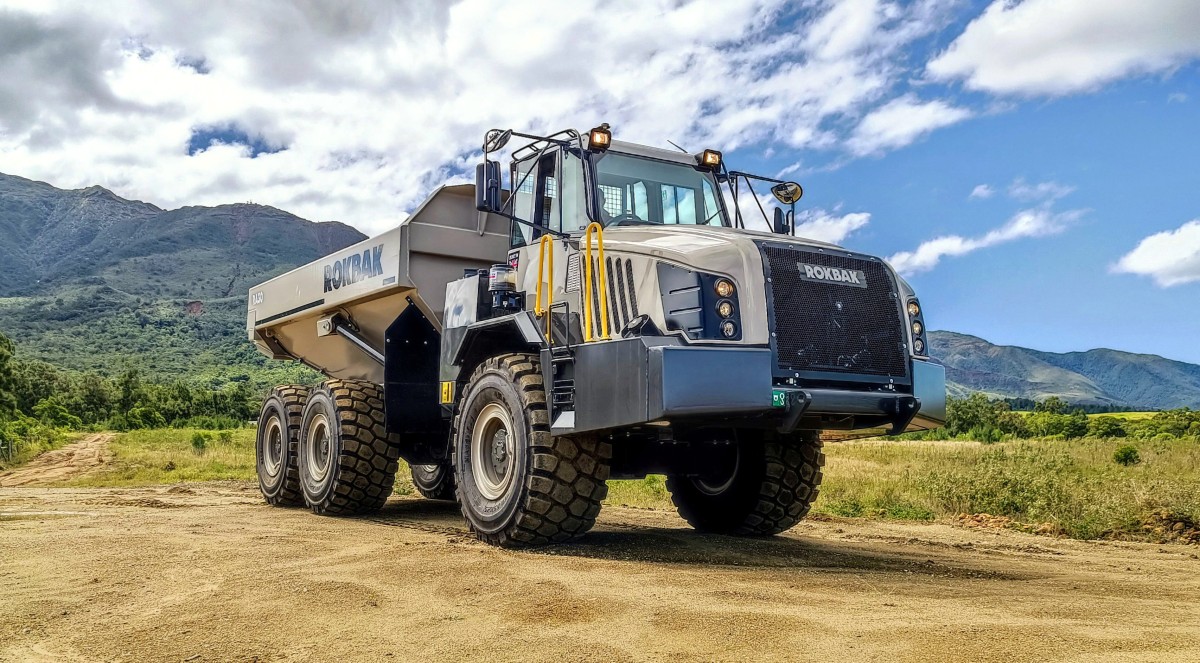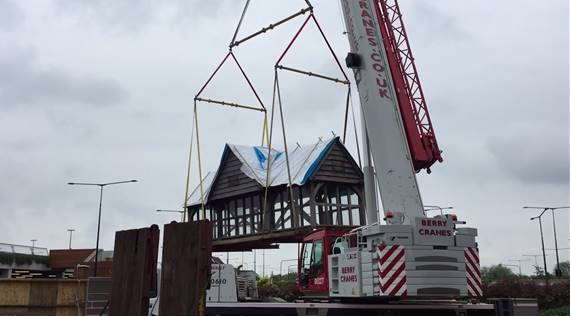Home \ International \ Berry Cranes uses Modulift Beams to Lift Bus Shelter
Berry Cranes uses Modulift Beams to Lift Bus Shelter
01/08/2017
Pubblicato da Redazione
Northampton, UK-based rental company Berry Cranes Ltd used an all-terrain crane rigged with a one-over-two Modulift spreader beam configuration to lift a wooden bus shelter at the Bicester Village shopping outlet in
Northampton, UK-based rental company Berry Cranes Ltd used an all-terrain crane rigged with a one-over-two Modulift spreader beam configuration to lift a wooden bus shelter at the Bicester Village shopping outlet in Oxfordshire recently.
Berry was tasked to lift the fragile 12.5t bus shelter from its roadside location, relocate it to a storage area half a mile away, and eventually return it to another location at the retail village. It had to be moved to accommodate important roadworks at its original position. Integral to the operation was three spreader beams from below-the-hook equipment manufacturer Modulift. Berry chose a Tadano ATF 70-G4 from its 12-crane fleet, a MOD 24 spreader, two MOD 12s, and a variety of other rigging equipment to complete the initial lift. The same equipment will be employed when it’s time to reposition the bus shelter in due course. The crane used 30m of main boom, which provided 22.8t capacity at 6m radius.
Greg Allen, contract lift operations manager at Berry Cranes, said: “The biggest issue was that the bus shelter was originally built in situ during the 1960s so no-one could know how stable it was until we lifted it. Further, the lift required extensive planning as the location gets extremely busy during hours when the retail park is open to shoppers.” Berry provided a crane operator, lift supervisor and two riggers, while the client supplied a structural engineer and two carpenters. Special steel beams were manufactured and placed underneath the structure, creating a cradle for the load as it was lifted. Prior to delivery to site the beams were tested in accordance with Lifting Operations and Lifting Equipment Regulations (LOLER) 1998.
Before the lift, the ground was dug from beneath the bus shelter in two positions to allow contractors to slide two beams lengthways underneath the structure. Jacks were used to lift the large beams with the shelter sitting on them to allow four smaller beams to be slid widthways underneath the larger ones. Fabricators then installed lifting bolts onto the ends of the smaller beams to attach the shackles. Berry utilised the MOD 24 spreader beam at 5.5m (18 ft.); it can lift up to 24t at 5m (17 ft.) and used up to 8m (26 ft.) at lower capacities. The pair of MOD 12 beams was used at 4m (13 ft.); they are capable of lifting 12t at 4.75m (15 ft.), while lower capacities are possible up to 6.5m (21 ft.). The beams and additional rigging equipment, including a variety of slings and shackles, were sourced from Berry’s extensive below-the-hook stock. One-over-two spreader beam configurations are particularly common when there are four lifting points. However, in this case, Berry attached two slings at each of the four corners of the rig to connect to shackles and the steel beams beneath the bus shelter.
Greg Allen concluded: “Combining expertise and quality equipment, we were able to complete the project safely and efficiently, only closing a small area of the car park to complete the lift and escort the load away from the site on specialised transport. We had previously lifted a 27t yacht with a MOD 50 [which can lift up to 50t at 8m or 26 ft. and up to 13m or 42 ft. at lower capacities] and regularly employ Modulift’s products, so we are familiar with the innovation they can facilitate below-the-hook of our cranes.” Berry’s fleet, of which five are all-terrain cranes, includes Liebherr’s 100th UK-delivered 60t capacity LTM 1060-3-1 mobile that arrived in May 2017
Ultime notizie di

01/07/2021
The compact Sennebogen 613 E telescopic mobile crane proves its flexibility and safety in the mine
Südwestdeutsche Salzwerke AG welcomed a new Sennebogen 613 E...

07/11/2019
COMANSA presents its new 21LC1400 model
A new large-capacity Flat-Top crane

26/09/2017
Robbins Slurry TBM ramps up for Mumbai Metro Line 3
The first of two Slurry TBMs, a rebuilt 6.65 m (21.8 ft) dia...

23/09/2017
The world’s strongest rope for the German Zugspitzbahn
For walkers and winter visitors, there are two ways to ride...

21/09/2017
Modulift beams suspend full scale model fighter jet
Four Modulift spreader beams were used to suspend a full sca...

20/09/2017
A tunnel project with PSC Crane & Rigging
PSC Crane & Rigging, headquartered in Piqua, Ohio, supplied...
Altri International

International
23/11/2024
GPMat International takes delivery of two Raimondi T147s residential development in the South of France
- Official agent of France expands its product lineup with t...

International
22/11/2024
Sarens acquires additional SCHEUERLE SPMT K24 modules
renowned for its expertise in crane rental services, heavy l...
International
22/11/2024
Five WOLFF cranes modernize Oslo’s Ulven district
With a total of five WOLFF cranes of type 7534.16 Clear, Wol...

International
21/11/2024
Kleemann: New compact crusher used for recycling
Impact crusher MOBIREX MR 100i NEO impresses during operatio...
International
21/11/2024
SITECH partners with Royal Engineers to create poppy and demonstrate tech offering
The demostration involved creating a ground-level poppy desi...

International
20/11/2024
Strong and stable RA30 trucks carry the weight at New Caledonian mine
Three Rokbak RA30 trucks are delivering exceptional durabili...








































